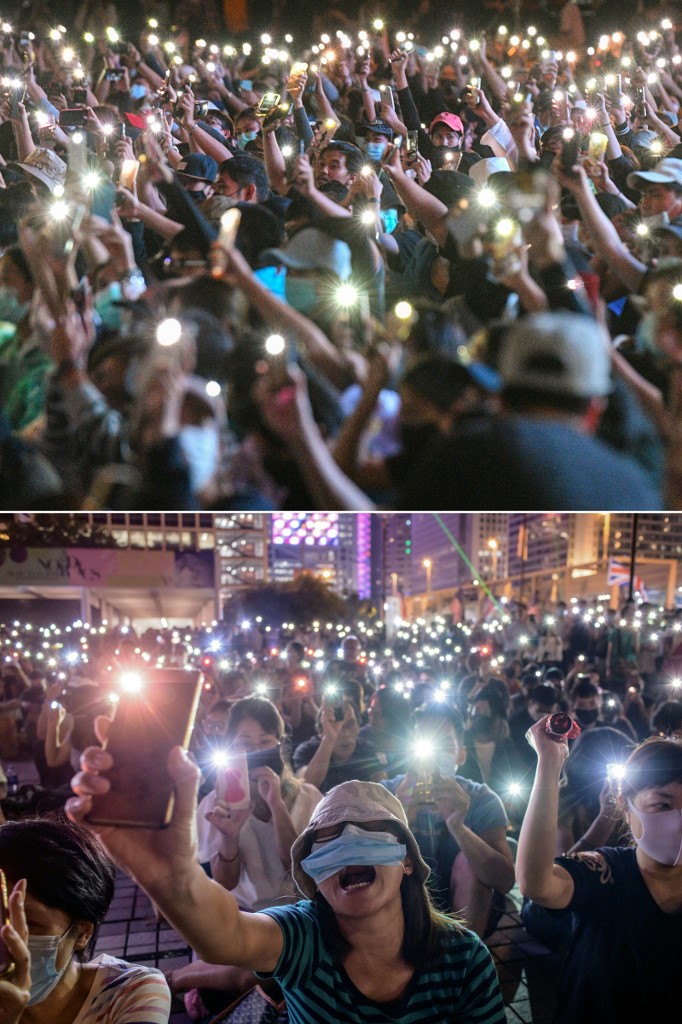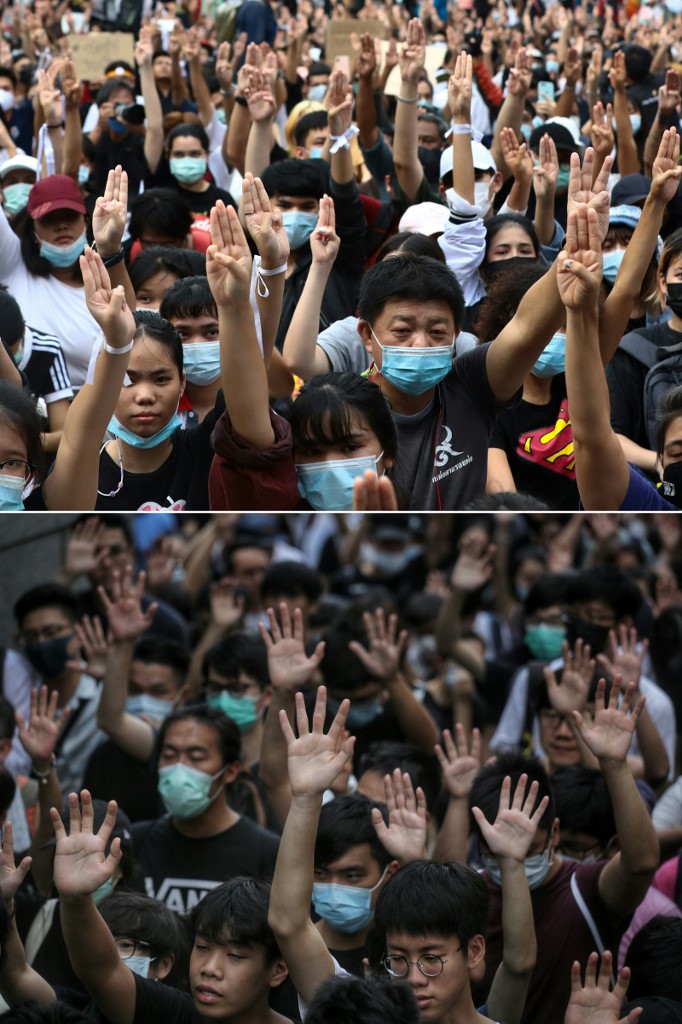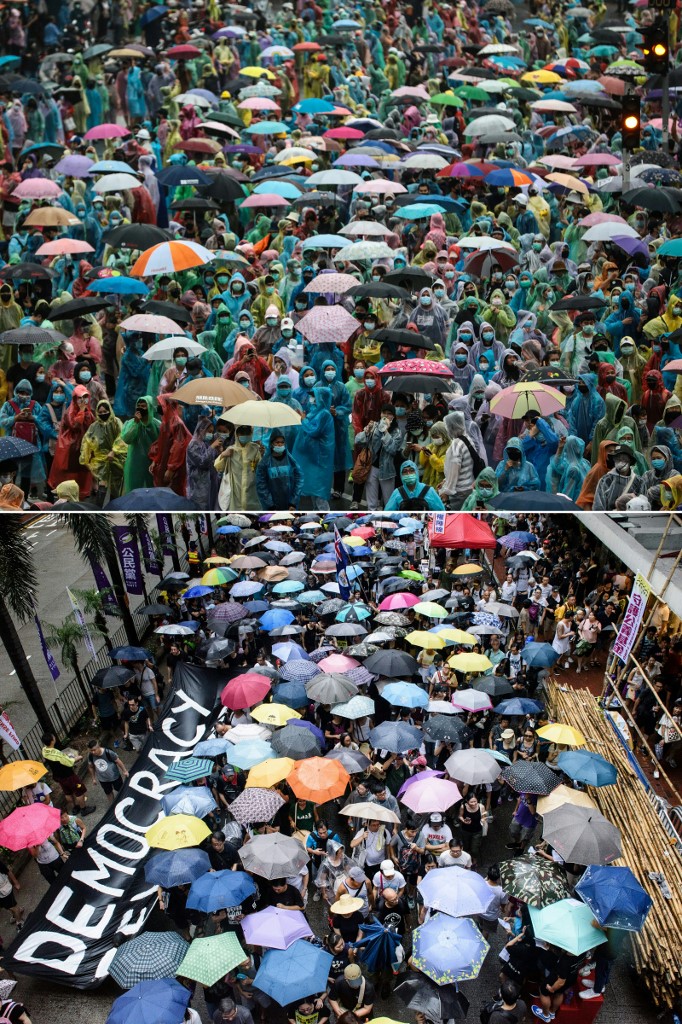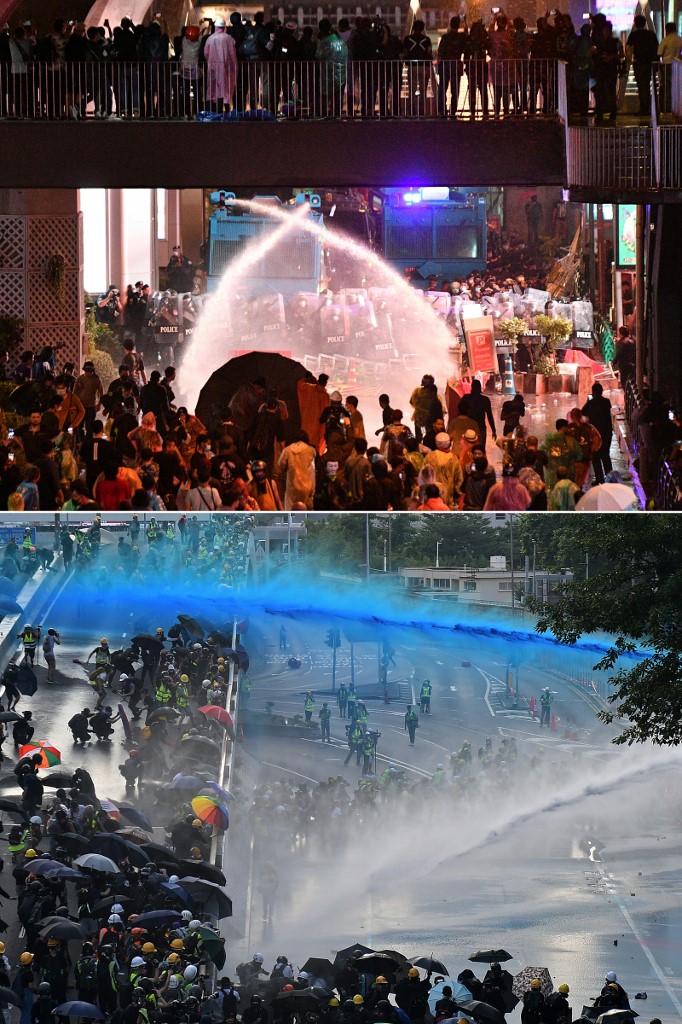
By CLAIRE GALOFARO
TROY, Mich. (AP) — She walks with the determination of a person who believes the very fate of democracy might depend on the next door she knocks on, head down, shoulders forward. She wears nothing fussy, the battle fatigues of her troupe: yoga pants and sneakers. She left her Lincoln Aviator idling in the driveway, the driver door open -- if this house wasn’t the one to save the nation, she can move quickly to the next.
For most of her life, until 2016, Lori Goldman had been politically apathetic. Had you offered her $1 million, she says, she could not have described the branches of government in any depth. She voted, sometimes.
Now every moment she spends not trying to rid America of President Donald Trump feels like wasted time.
“We take nothing for granted,” she tells her canvassing partner. “They say Joe Biden is ahead. Nope. We work like Biden is behind 20 points in every state.”

Lori Goldman, talks with a voter while canvassing in Troy, Mich. (AP Photo/Paul Sancya)
Goldman spends every day door knocking for Democrats in Oakland County, Michigan, an affluent Detroit suburb. She feels responsible for the country’s future: Trump won Michigan in 2016 by 10,700 votes and that helped usher him into the White House. Goldman believes people like her -- suburban white women -- could deliver the country from another four years of chaos.
For many of those women, the past four years have meant frustration, anger and activism — a political awakening that powered women’s marches, the #MeToo movement and the victories of record numbers of female candidates in 2018. That energy has helped create the widest gender gap — the political divide between men and women — in recent history. And it has started to show up in early voting as women are casting their ballots earlier than men. In Michigan, women have cast nearly 56% of the early vote so far, and 68% of those were Democrats, according to the voting data firm L2.
“I hate the saying, 'when they go low, we go high.' That’s loser talk. You can be right all day, but if you’re not winning, what’s the point?”
LORI GOLDMAN
That could mean trouble for Trump, not just in Oakland County but also in suburban battlegrounds outside Milwaukee, Philadelphia and Phoenix.
Trump has tried to appeal to “the suburban housewives of America,” as he called them. Embracing fear and deploying dog whistles, he has argued that Black Lives Matter protesters will bring crime, low-income housing will ruin property values, suburbs will be abolished. Campaigning in Pennsylvania last week, he begged: “Suburban women, will you please like me?”
There’s no sign all this is working. Some recent polls show Biden winning support from about 60% of suburban women. In 2016, Democrat Hillary Clinton won 52%, according to an estimate by the Pew Research Center.
Talk to women across suburban Michigan, and you’ll find ample confirmation: the lifelong Republican who says her party has been commandeered by cowards. The Black executive who fears for the safety of her sons. The Democrat who voted for Trump in 2016 but now describes him as “a terrible person.”
Together, they create a powerful political force.
Goldman started her group, Fems for Dems, in early 2016 by sending an email to a few hundred friends that said she planned to help elect the first female president and asked if they’d like to join her. Four years later, their ranks have swelled to nearly 9,000.
There is one thing Goldman gives Trump credit for. He stormed into the White House on pure guts and bombast, unwilling to acknowledge failure, averse to saying sorry. Those are not natural traits for most women who’ve absorbed societal expectations to please and be polite, she says. But she dug deep within herself to find some hint of them.

Lori Goldman poses for a portrait next to campaign signs outside her home in Bloomfield Village, Mich. (AP Photo/Paul Sancya)
A married real estate agent with 12-year-old triplets and a 23-year-old daughter, she became simultaneously the stereotype of a suburban woman and its antithesis: She lives in a 6,000-square-foot home with seven bathrooms, and drinks Aperol spritzers. She also peppers almost every sentence with curse words and no longer gives one damn what people think.
“I hate the saying, ‘When they go low, we go high.’ That’s loser talk,” she says. “You can be right all day, but if you’re not winning, what’s the point?”
And it’s worked: She described her coalition to a newspaper once as “a bunch of dumpy, middle-aged housewives,” and a few got mad at her, but far more joined.
But she is terrified that the constant cycle of crises has left many women exhausted and that could stall this leftward lurch. The nation is reeling from a pandemic and protests, the death of a revered Supreme Court justice, the hospitalization of the president, a foiled plot to kidnap Michigan’s governor.
“Our house is on fire,” Goldman says, and so she steers her SUV to the next door on the cul de sac.
ADVERTISEMENT
___
Oakland County stretches from the edge of Detroit more than 30 miles, through moneyed subdivisions, quaint small towns and swanky shopping districts, into rural stretches with dirt roads and horse pastures. Goldman has covered nearly every inch of it.
Although Clinton won here in 2016, she won fewer votes than Barack Obama four years earlier, while the third-party vote soared. If Clinton had matched Obama’s total, Oakland County alone might have cut Trump’s margin of victory in Michigan by more than half.
But in 2018, some political scientists described it as the epicenter of a major political shift as women turned on Republicans.
“Women are pragmatic voters,” said Michigan’s Democratic governor, Gretchen Whitmer. “We care about our kids. We care about our parents. We care about economic security. And so candidates who stand up for those values and show that they can be good, decent human beings is something I know resonates. And I think this moment, with this White House, that is more acute than ever.”

Michigan Gov. Gretchen Whitmer campaigns with Dan O'Neil, a Democratic candidate for the Michigan House in Traverse City, Mich., Oct. 9, 2020. (AP Photo/John Flesher)
Whitmer nearly doubled Clinton’s margin in Oakland County in 2018. That same year, Democrat Elissa Slotkin flipped a congressional seat that was under Republican control for almost 20 years.
Some of Slotkin’s strongest supporters were Republican women.
Nancy Strole, a longtime elected township clerk in the rural northern part of the county, had not been able to bring herself to vote for Trump. She considers herself an “old-fashioned kind of Republican.” She hasn’t changed, she said — her party was “hijacked.”
“It’s not just Trump,” she said. “It wouldn’t happen unless there are others who acquiesced and were willing to go along with it either by their silence, by their lack of will, by their lack of courage.”
When Trump began his presidency by undermining international alliances and routinely denigrating people, she grew frustrated that Republicans did nothing about it.
Strole said she called her congressman, Mike Bishop, and never heard back. Meanwhile, Slotkin, a former CIA analyst, announced her bid against Bishop. Her reason for running jibed with Strole’s growing consternation: She had watched Bishop stand by at the White House, smiling, as Republicans worked to gut the Affordable Care Act.

Nancy Strole poses for a portrait in Springfield Township, Mich. (AP Photo/Paul Sancya)
In a lifetime as a Republican, Strole had never volunteered for a congressional campaign. But she knocked on 1,000 doors for Slotkin.
Andrea Moore, by contrast, was raised in a Democratic family. But she voted for Trump because she was fed up with career politicians who seemed interested only in money and power.
“He was an unknown quantity, but now we know,” said Moore, 45, who lives in a suburban community in Wayne County.
She can’t remember the precise moment she decided she’d made a mistake. It felt like a toxic relationship: You can make excuses for a while, but eventually disgust settles in.
“A million little things,” she said — the rapid-fire attacks on people, divisiveness, fear mongering. “They just kind of piled up.”
She can’t understand how anyone could support Trump after his response to his own bout with COVID-19 — how he flouted masks and held rallies, downplayed the threat, failed to acknowledge that he had access to treatments that others don’t, she said. All this when more than 219,000 Americans have died.
Moore, a stay-at-home mom who home-schools her 9-year-old son, doesn’t love Biden. But if the choice is between Trump and anyone else, she said, anyone else will do. She hopes the administration will be driven by Kamala Harris — a Black woman, the child of immigrants, young, sharp.
“It’s been an old white guy’s game for way too long,” Moore said.
___

President Donald Trump arrives for a campaign rally at MBS International Airport, Sept. 10, 2020 in Freeland, Mich. (AP Photo/Evan Vucci)

Democratic presidential candidate former Vice President Joe Biden speaks during a campaign event with steelworkers in the backyard of a home in Detroit, Sept. 9, 2020. (AP Photo/Patrick Semansky)
Trump’s pitch to try to reclaim suburban female voters relies on an airbrushed version of America’s past. He has warned that “Biden will destroy your neighborhood and your American dream.” He revoked an Obama-era housing initiative meant to curtail racial segregation, claiming that property values would diminish, crime would rise and suburbs would “go to hell.”
“I think if this were 1950, his message would be perfect,” said Karyn Lacy, a sociologist at the University of Michigan. “The problem is it’s not 1950.”
Trump’s description of the suburbs seems to Alison Jones like nostalgia for “a `Leave it to Beaver’ time” when people who look like her could not have lived in her subdivision, where no house costs less than $1 million.
Now when Jones, a Black woman, sees Trump lawn signs, she wonders: Do her neighbors really want her here?
“I think 2020 has opened the wounds, pulled back the curtain so we can see what’s really here.”
ALISON JONES
Suburbs like this were once exclusively white by design: The federal government long underwrote segregationist policies that kept Black families out. Even now, Oakland County remains very white, but not as white as it once was. In 1990, the county was 88% white. By 2019, that dropped to 71.5%.
Jones watched as Trump stood on a debate stage and declined to condemn white supremacy, telling a hate group to “stand back and stand by.” She was a child in the South in the 1960s, when schools were integrating, and the message felt very familiar: It’s us against them.
She fears for her two sons, maybe even more in this predominantly white community than she would in a city, she said. In 2018, a Black 14-year-old boy got lost not far from where she lives and knocked on a door to ask for directions. The white homeowner shot at him.

Alison Jones poses for a portrait outside her home in Rochester, Mich. (AP Photo/Paul Sancya)
Jones believes the United States has reached a critical point. Police killings have exposed systemic racism, COVID-19 has disproportionally killed Black people, and they have borne the brunt of the economic fallout, too. “I think 2020 has opened the wounds, pulled back the curtain so we can see what’s really here.”
An executive at a Fortune 500 company, Jones moved here for the same reason as everybody else: good schools, secure property values, safety.
And like Jones, many women here work outside the home. Households aren’t all as they were depicted when Beaver and Wally lived in the fictional town of Mayfield.
Linda Northcraft moved to Oakland County in 1997 for a job as a rector of an Episcopal church, and bought a home with her partner, Ellen Ehrlich.

Ellen Ehrlich and Linda Northcraft pose for a portrait in Southfield, Mich. (AP Photo/Paul Sancya)
Some in the congregation left. “Gay priest splits parish,” the headline read. Skinheads protested in the parking lot. It was devastating, and some from their old church suggested maybe they should move back to Baltimore.
But they stayed, times changed, and they got married. Ehrlich said “my wife” recently to a stranger and reported back to Northcraft: “They didn’t even blink an eye,” she said. “It’s become normal.”
They became active in Democratic politics when Whitmer was running for governor. Before dinner, they pray for people sick from COVID-19, for Biden and Harris and, until recently, for Justice Ruth Bader Ginsburg.
Ehrlich had been in a “mini state of depression.” She’s an extrovert and the shutdown to curtail the spread of the coronavirus had left her demoralized. But Ginsburg’s death energized her. Without even speaking of it, they both understood the stakes: A stronger conservative majority on the Supreme Court could undo years of expanding protections for civil rights — including their own right to be married.
They sat down the next morning and made campaign donations to every Democrat they could think of.
___

Lori Goldman poses for a portrait in Bloomfield Village, Mich. (AP Photo/Paul Sancya)
Lori Goldman doesn’t enjoy knocking on strangers’ doors, asking them to vote for Democrats.
She’s hungry because she often doesn’t take the time to eat. Her knee aches from a replacement surgery six months ago. Often the houses have Trump flags hanging from the porch rails.
“But this is war,” she says, and she considers herself a street fighter.
People look at her and make assumptions, she said: a $2 million house, fancy car, American Express black card that she always loses because she keeps it in her bra. But she grew up in a steel town not far away, one of six kids raised by a single mother, poor, dependent on government cheese.
Most of her family and childhood friends are Trump supporters, so she knows there are many whose minds she won’t change.
Like Ally Scully, 27, who hesitantly voted for him in 2016. She believes in traditional small-government Republican ideals like tax cuts and supporting small business. She prayed over her decision and walked into the booth still unsure. Now she thinks he earned her vote again.
“I’m surprised to be saying that because I didn’t think he would,” she said. “I think it’s just his willingness to go out on a limb, even if it was unpopular, that boldness has been remarkable.”

Ally Scully poses for a portrait outside her apartment building in Rochester, Mich. (AP Photo/Paul Sancya)
She believes he’s empowered women in his administration — including his own daughter — and thinks claims of his racism and sexism are overblown by the media. Scully, who now leads the county’s young Republican club, acknowledges that many women have fled the GOP under Trump. But she also believes another, quieter contingent is going the other way.
Goldman worries that she’s right.
But then again, some things have happened to spur more women to battle Trump.
Earlier this month, her phone started ringing one morning with call after call from women asking to knock on doors with her. The catalyst: Six men were charged with conspiring to kidnap Gov. Whitmer because of her “uncontrolled power.”
Whitmer has been a persistent target of right-wing vitriol since she implemented a strict lockdown to try to contain the coronavirus. Thousands of men stormed into the Capitol with guns. Trump egged them on: “Liberate Michigan,” he tweeted, dismissing Whitmer as “the woman from Michigan.”
Whitmer felt it was her duty to publicly blame Trump. Most women, she said, have been on the receiving end of belittling comments.
“I’m at a point in my life where I’m going to take it on every time,” she said. “There’s no room for it. I don’t have time to waste. I have a job to do.”
Women approached her at events to thank her, she said. Some said they were Republicans, tired of the divisiveness and determined to make a change.

Lori Goldman walks between houses as she canvasses in Troy, Mich. (AP Photo/Paul Sancya)
Goldman heard the same thing. “It’s because she’s a woman who dared to speak up and so now a bunch of men are going to teach her a lesson,” she said. “This is the violent version of mansplaining, and it’s happened since Adam and Eve.”
So Goldman conjures her Trumpian bluster. Sometimes she stands up in the middle of Starbucks and bellows, “Who here can’t take it anymore? Who wants this guy out of office?”
Some fraction of the room will be furious, but that’s OK with her, because some fraction will ask how they can help. Fems for Dems swells.
Her group has about 8,900 members. But that’s not what Trump would say, so it’s not what she does, either.
“Over 9,000,” she says. “And growing.”
___
Associated Press journalists David Eggert, Hannah Fingerhut, Emily Swanson and Angeliki Kastanis contributed to this report.





















